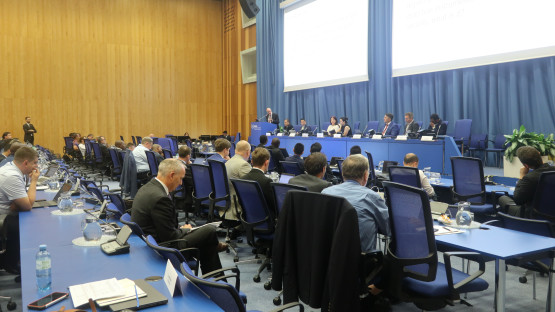Innovative ideas on how artificial intelligence, machine learning, uncrewed aerial systems and other technologies can be used to enhance existing radiation detection capabilities for nuclear security are being explored by many countries around the world.
During an IAEA technical meeting held from 14 to 18 August 2023, best practices, accomplishments, and challenges in the use of radiation detection equipment for nuclear security were shared by more than 150 experts from over 75 countries. The experts participated in active discussions on radiation detection tools, technologies, and techniques in a mix of plenary and smaller topical sessions, as well as smaller breakout working sessions.
“The experience and expertise of the meeting participants ran the gamut from research to development and testing, and from frontline officers to senior decision makers,” said Itimad Soufi, Head of the IAEA’s Nuclear Security of Materials Outside of Regulatory Control Section, adding that “this broad cross-section participation supported important discussions on the safety-security interface that will improve the use and sustainment of radiation detection equipment.”
Indonesia was among the countries presenting its work on advances in the performance of portable radiation detectors for nuclear security using open-source software.
“In the Indonesian archipelago, nuclear security relies heavily on the effective operation and networking of radiation detection equipment in multiple locations spread along its vast coastline,” said Kristedjo Kurnianto, Senior Researcher for Indonesia’s Research Center for Radiation Detection and Nuclear Analysis Technology.
“We are utilizing cross-cutting technology for radiation detection. By effectively leveraging several emerging technologies, we have enhanced Indonesia’s nuclear security measures. Indonesia has set an example of harnessing innovation to improve nuclear security,” Kurnianto said.
The meeting centered around applying emerging technologies for radiation detection in nuclear security and emphasized the need to better support the role of frontline officers (FLOs) in nuclear security. “The latest advancements in radiation detection are putting frontline officers’ operational needs and challenges front and center by prioritizing technological development that simplifies and supports their work,” said Alina Smyslova, Deputy Program Director of Sustainability for the Office of Nuclear Smuggling, Detection and Deterrence of the United States Department of Energy National Nuclear Security Administration, and co-chair of the meeting.
The IAEA decision making support tools developed specifically to assist FLOs in carrying out their nuclear security activities were presented during the meeting. The Tool for Radiation Alarm and Commodity Evaluation (TRACE) and the software Mobile Integrated Nuclear Security Network (M-INSN) are both available to countries to help them enhance their radiation detection operations and capabilities.
In addition, a new smartphone application named Personnel Alarm Assessment Tool (PAAT) is presently undergoing testing to be released publicly by the end of this year. These smartphone applications enhance knowledge transfers and the efficiency and effectiveness of radiation detection alarm assessments, reduce subjectivity in alarm assessment, and provide greater command and control of nuclear security options.
During the meeting, which was supported financially by the United States of America, participants received hands-on technical demonstrations of radiation detection technologies and decision making support tools. Prominent discussion outcomes centered heavily on leveraging emerging technologies to address pressing technical limitations, such as supporting ongoing technological sustainment, and human resource constraints including the current need for extensive training on many of the instruments used for radiation detection operations.
Participants discussed how improvements in detector and data analysis technologies can facilitate more streamlined communication and sharing of information for decision makers. This could ensure a coordinated approach when responding to a radiation detection event.
“These are important areas that will advance radiation detection technology for nuclear security,” said May Bee Leng Ong, co-chair and Director for Chemical, Biological, Radiological, Nuclear and Explosives (CBRNE) at the CBRNE Center of Expertise at the Singapore Science and Technology Agency. “As a result of this meeting, I foresee greater international cooperation in radiation detection for nuclear security. Enhancing radiation detection and security is not a pure technological pursuit. It ought to be a commitment to safeguard the peace, resources and stability for our shared future.”
In October 2023, the IAEA is organizing a technical meeting to discuss countermeasures to uncrewed aerial system threats to nuclear security.





